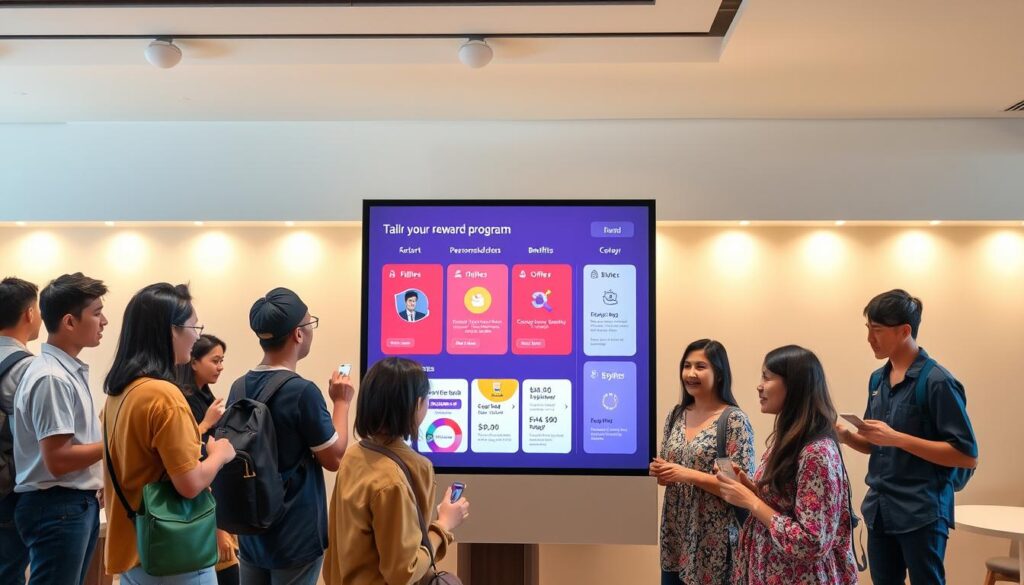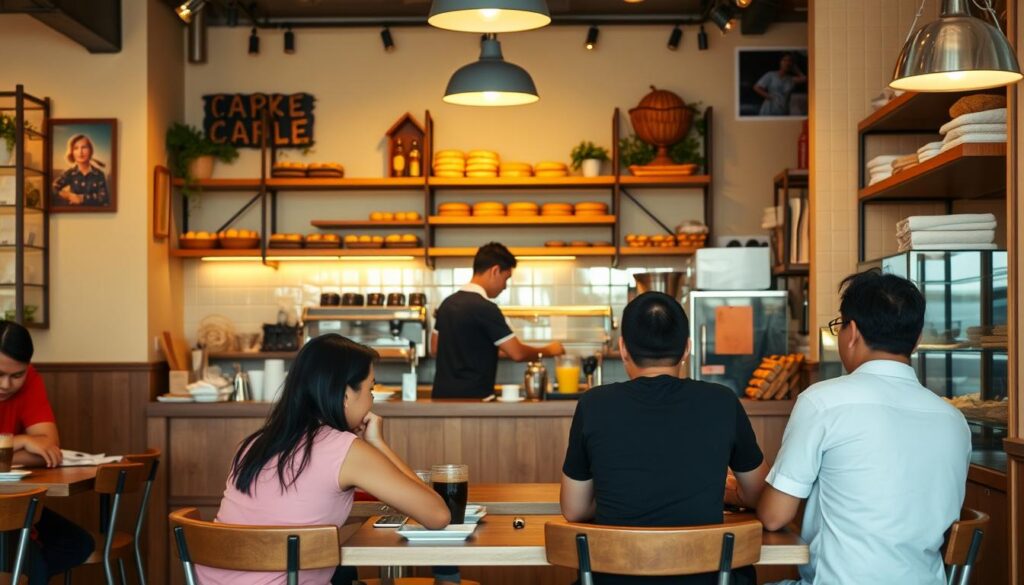Ever thought why your favorite brands sometimes get their loyalty programs wrong? In today’s diverse market, like Southeast Asia, it’s clear we need personalized loyalty programs. A one-size-fits-all approach just doesn’t connect with people who want real, customized experiences. This article dives into the key parts of making loyalty programs personal, showing how tailored rewards meet each customer’s needs. It’s time to see why making loyalty programs personal is key to staying ahead in the changing retail world.
Key Takeaways
- Personalized loyalty programs enhance customer engagement and satisfaction.
- One-size-fits-all strategies can alienate consumers who seek tailored rewards.
- Understanding modern consumer expectations is vital for effective loyalty programs.
- Customized rewards significantly boost retention rates.
- Embracing customer loyalty customization leads to stronger brand loyalty.
The Changing Landscape of Customer Loyalty
The world of customer loyalty is changing fast. Brands are looking at new ways to connect with their customers. This change is driven by what today’s consumers expect from brands.
Old point-based systems are no longer enough. Customers want more than just points. They want real connections with the brands they support.
Understanding Modern Consumer Expectations
Today’s shoppers know what they want from brands. They seek experiences that touch their hearts and match their values. Brands must meet these expectations to stay ahead.
Creating deep emotional connections with customers is key. This approach builds lasting loyalty.
The Shift from Points to Experiences
Customer loyalty is moving from points to experiences. Surveys show people value experiences more than points. This includes things like special events and personalized offers.
This change shows that businesses need to offer more than just products. They must create memorable experiences that go beyond the sale.
What Are Personalized Loyalty Programs?
Personalized loyalty programs are a big change in how companies talk to their customers. They use data to make rewards and offers fit each person’s shopping habits and likes. This way, brands can build stronger connections and make customers happier.
Defining Personalization in Loyalty Contexts
Personalization in loyalty means making experiences and rewards special for each customer. It’s not just about generic stuff. It’s about tailored loyalty solutions that show each shopper’s unique side. For example, these programs might give special discounts on items you buy a lot, which encourages you to buy more and stay loyal.
Key Features of Effective Loyalty Programs
Good loyalty programs have some key things that make customers happy and keep them coming back:
- Flexibility in Rewards: Customers like to choose how they get and use rewards.
- Real-Time Offers: Quick alerts about deals or specials can lead to buying right away.
- Engagement Metrics: Businesses need to know what customers do to make their offers better.
Brands like Lazada show how these features work well. They use customer data to make their loyalty programs better. This helps them run campaigns that really connect with people. It shows how valuable personalized loyalty programs can be.

The Importance of Customizing Rewards
In today’s world, customizing rewards is key. It meets customer needs and boosts loyalty. When rewards match what customers like, they feel special and valued.
Meeting Individual Customer Needs
Custom rewards help brands connect better with people. Today, customers want personalized reward systems that show they care. This builds strong bonds, as people feel seen and heard.
Retailers like Starbucks show how it works. They offer tailored rewards that make customers happy.
Case Study: Successful Personalization Examples
Sephora’s Beauty Insider program is a great example. It gives rewards based on what you buy and like. This makes customers feel like they’re getting something special.
NikePlus is another success story. It gives users rewards based on their activity. This makes users feel part of a community.
By focusing on personalization, these brands lead the way. They show that knowing and meeting customer needs is key to loyalty.
| Brand | Loyalty Program | Customization Features | Impact |
|---|---|---|---|
| Sephora | Beauty Insider | Personalized rewards based on purchase history | Higher retention and satisfaction |
| Nike | NikePlus | Activity-based suggestions and rewards | Enhanced user engagement and community feeling |
Customizing rewards is a big change in loyalty strategies. It helps businesses stand out by focusing on what customers want. This approach is a big win in a competitive market.
Why One-Size-Fits-All Loyalty Programs Fail
Traditional loyalty programs often fail because they don’t account for demographic variability. Brands that use a one-size-fits-all approach may lose some customers, like younger ones. It’s important to understand the differences in age, culture, and shopping habits to create good loyalty programs.
Understanding Demographic Variability
Each group has its own shopping likes and reasons. For instance, a loyalty program failure can happen if brands think everyone is the same. Knowing how different groups respond to rewards is key. Brands that stick to the same plan for everyone miss out on what their audience really wants.
The Gen Z Mindset Towards Loyalty Programs
Gen Z wants real connections with brands. They look for more than just discounts; they want experiences that match their values. This generation cares about being included, sustainable choices, and quick responses from brands. If brands ignore these, they miss a chance to build loyalty.

Getting the unique views of different groups, like Gen Z, can change how loyalty programs work. Brands that adjust their plans based on these insights can build stronger, lasting relationships with their customers.
Data-Driven Personalization Strategies
Loyalty programs work best when they use data to understand customers. Brands can make their programs better by using customer data wisely. This way, they can offer experiences that really speak to each person’s likes.
Leveraging Customer Data for Tailored Experiences
Using customer data helps businesses create experiences that fit each person’s needs. They look at what customers buy, what they like, and who they are. This lets them make special offers that match each group’s interests.
For example, Grab has made their loyalty program better with data. They use what they learn from users to make offers that customers love. This makes customers happier and more loyal.
Utilizing Behavioral Insights to Improve Engagement
Knowing how customers behave is key to making loyalty programs better. Insights from how customers act help brands talk to them in a way that really connects. This makes customers not just loyal, but also builds lasting relationships.
Using data and understanding customer behavior can make customer engagement better everywhere. It’s a powerful way to improve how brands connect with their audience.
Enhancing Customer Experience Through Personalization
In today’s fast-changing world, brands must focus on making customer experiences better. Personalization is key to creating smooth interactions. It lets businesses meet customers’ specific needs and likes right away.
Old loyalty programs were all about earning points over time. But now, people want rewards right when they need them. This change is a great chance for brands to get creative.
Creating Seamless and Relevant Interactions
Brands that use personalized messages and special offers can connect better with their customers. By studying what customers do and like, brands can send messages that really hit home. This makes customers happier and more loyal.
For example, local restaurants can send special deals based on what a customer has ordered before. This turns a regular meal into a special treat.
Real-Time Rewards versus Traditional Points-Based Systems
Old loyalty programs often seem out of date. They make customers wait a long time to get rewards. But real-time rewards give benefits right away, which is what today’s shoppers want.
Companies like Grab have made this work by giving users instant discounts or perks. This makes customers happier and more likely to keep coming back.
| Reward Type | Features | Consumer Appeal |
|---|---|---|
| Traditional Points System | Incentives based on accumulation over time | Delayed gratification |
| Real-Time Rewards | Instant benefits upon engagement | Immediate satisfaction |

Challenges in Implementing Personalized Loyalty Programs
Starting personalized loyalty programs can be tough for businesses. They face the challenge of balancing personalization with privacy concerns. This is crucial, as Gen Z values their privacy and wants tailored experiences.
Balancing Privacy Concerns with Personalization
Companies use customer data for personalized loyalty programs. But, they must protect this data to keep customers’ trust. It’s important to be open about how data is used and to meet customer expectations.
This focus on data ethics helps build trust between brands and their audience. It’s key to overcoming personalization challenges.
Overcoming Resistance to Change within Organizations
Switching to personalized loyalty programs can be hard for companies. Employees might resist new systems, and leaders may struggle to make the change work. To overcome this, training and clear communication are essential.
By teaching employees about the benefits and encouraging a culture of innovation, companies can adapt smoothly. This helps everyone move forward together.
Best Practices for Loyalty Program Personalization
Creating effective loyalty programs needs careful thought. It’s important to use various strategies. By doing so, you can greatly improve how customers interact with your brand.
Using interactive content and AI for personalized suggestions are key. Brands that use these methods see better customer retention and happiness.
Engaging Customers through Interactive Content
Interactive content is a strong tool for loyalty programs. Adding quizzes, polls, and gamified rewards makes experiences memorable. This approach grabs attention and boosts loyalty.
Utilizing AI for Tailored Recommendations
AI in loyalty programs offers real-time, personalized suggestions. It analyzes what customers like and buy. This shows customers you care about their needs, making their experience better.

Future Trends in Customer Loyalty Programs
The world of customer loyalty is changing fast. People want things easy and quick. Brands need to keep up to stay connected with their customers.
They must use new tech to make loyalty programs better. This means creating experiences that feel personal and special. It’s all about making customers feel valued.
Emphasis on Convenience and Instant Gratification
Today, shoppers love things that are easy and fast. They want loyalty programs that give them rewards right away. They want to get things without hassle.
Brands that make things simple will win over customers. They need to update their loyalty plans to match today’s fast life.
The Role of Technology in Shaping Loyalty Experiences
Technology is key in loyalty programs. Mobile wallets and AI are changing how brands talk to customers. For example, data can help predict what customers want and offer them special deals.
Asia is already seeing the power of tech in loyalty. It shows how technology can make loyalty programs better.
Conclusion
Personalized loyalty programs have become crucial in today’s marketing world. Knowing what customers want is key to making these programs work. Brands that focus on personalization can keep their customers engaged and interested.
In Southeast Asia, where people have different tastes, personalized loyalty programs are vital. They help businesses build strong bonds with their customers. This leads to more loyalty and happiness among customers.
Looking ahead, companies need to understand and meet their customers’ changing needs. Using data to guide their strategies can make loyalty programs more effective. This way, businesses can build lasting relationships with their customers in today’s fast-changing market.

